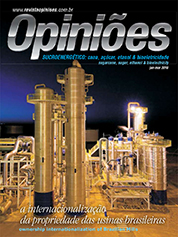Alexandre Enrico Silva Figliolino
Commercial Director of Itaú-BBA
Op-AA-23
Managment is an essential factor for success
It is quite interesting to develop the theme proposed by the Opiniões magazine for this article – ownership internationalization of Brazilian mills – on the very day that the most important and emblematic transaction ever to have taken place in the sugar and ethanol industry is announced: the joint venture between Cosan, the largest company in the industry, and Shell, the world’s second largest oil company.
For optimists, which I too am, it is irrefutable proof that renewable ethanol has its assured place in the world matrix of solid fuels, whereas sugarcane bagasse currently is the most promising raw material to produce second generation ethanol. To those who are less enthusiastic, I would like to quote a hilarious comment by a market analyst, according to which the oil companies today are like the Bahian dancers in a samba school, i.e., they are not a part of the plot, but if they are not present the samba school loses points in competition parading.
Thus, foreign capital, which 5 years ago participated with only 6% of the total sugarcane crushed by the industry, now accounts for significant 23%, in what is an evidently upward trend. Even though the Shell x Cosan transaction implies a higher concentration in fuel distribution in the domestic market, the potential this association may unleash in terms of expanding world trade in ethanol, is undeniable, allowing increased access to markets.
Along this same line of world trade expansion, one should see the significant improvement of Bunge’s ranking in the industry – it acquired the Moema Group and shows appetite for new business – and the important Indian group Renuka, which has been quite active in analyzing acquisition opportunities that have appeared in the market.
No doubt large foreign groups with facilitated access to capital have taken up front positions in the industry, which we may refer to as the A series – a reference only to size, given that we are classifying them from the top downwards, from large to small –, in what is a characterization of companies with a strong consolidation vocation, in which the stakes to get in are very high.
Also in this group one should classify ETH, since it belongs to one of the most admired Brazilian corporate groups, and Dreyfus, with its respectable 38 million tons capacity following the acquisition of Santelisa Vale. Furthermore, one may not forget Copersucar, with its successful “from the inside out” consolidation model, in which scale no doubt makes all the difference. This model is an interesting alternative to take into consideration by companies that, to a certain extent, are isolated.
Ranking under this above the 20 million mark forerunner platoon, there are many names with excellent management, which have been performing very well. These companies may possibly enter the consolidation game in an active way, should they associate with, or attract, capitalist partners. Of BNDES (National Economic and Social Development Bank) one expects more active participation in fostering strategic movements, thus allowing more Brazilian groups to take part in this heavyweight game of the so-called A series.
Based on the principle that the key to the comodities business is low cost, and that, in overall terms, 60% of the costs are in agriculture, almost 20% in distribution, 12% in production, and 8% are the so-called administrative costs, it becomes quite evident where the game is won in the first phase, i.e., in agricultural and distribution costs. Management is an essential factor for success in a management-intensive industry, in which the major challenges for large accelerated growth companies are in the agricultural part.
For example, in the current 09/10 harvest, with the data available until now, one can once again state that size is not what matters, to the extent that among top performers in terms of profitability – above an EBITDA (Earnings Before Interest, Taxes, Depreciation and Amortization) operational margin of 30% –, there are companies with an output of 3 million to 15 million tons.
However, this situation is not warranted for the future, since new technologies are appearing and management models are becoming better. But there is one thing warranted from the onset, which this crisis made very clear: to grow at an accelerated pace, in an industry with highs and lows (fortunately more highs than lows), in a financial market also of highs and lows, is only for large companies with high visibility, because only they have guaranteed access to the capital market, the only source allowing safe growth without hurdles.




